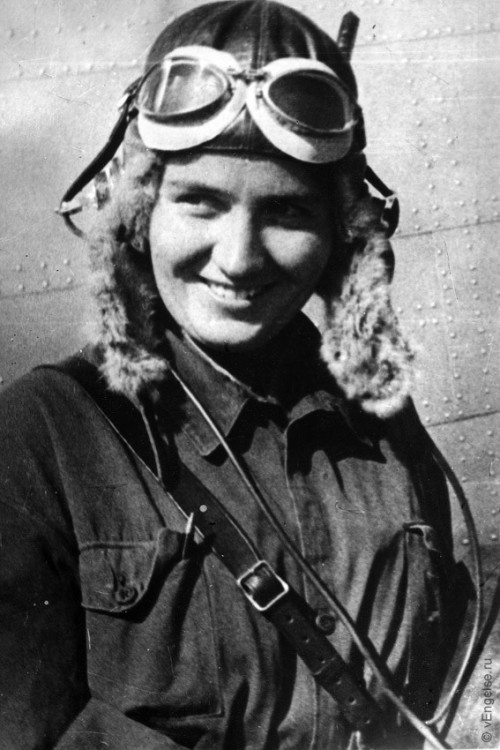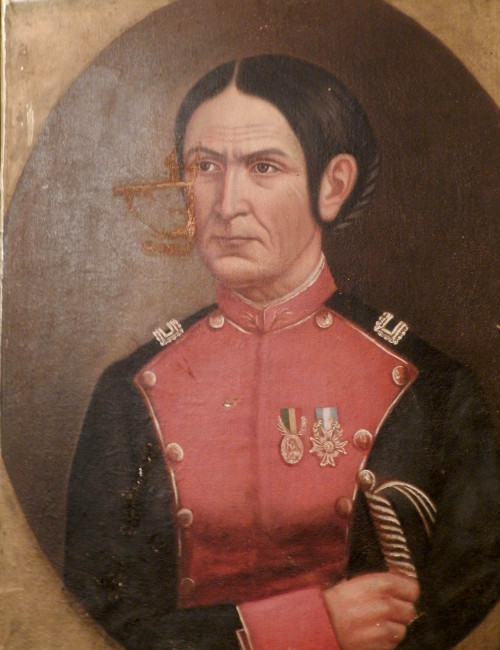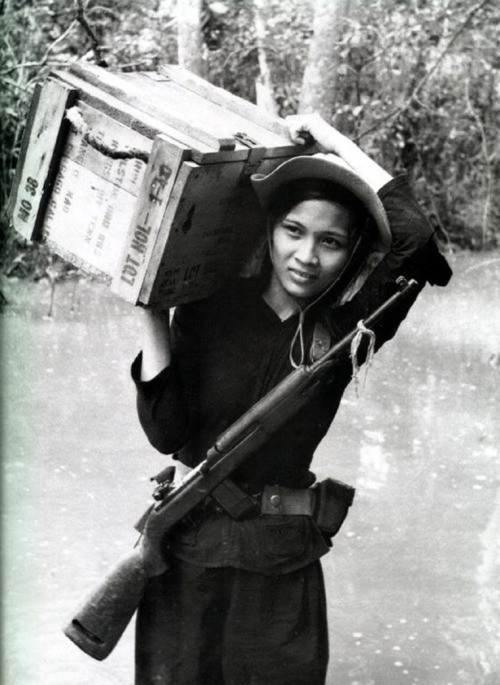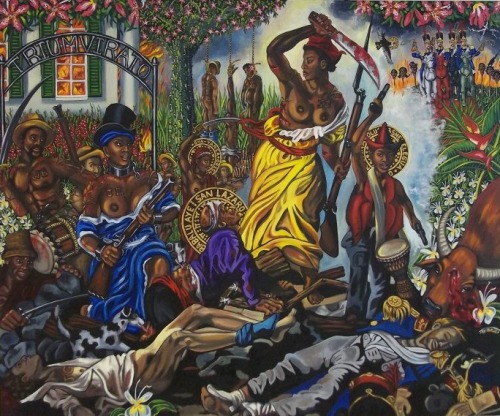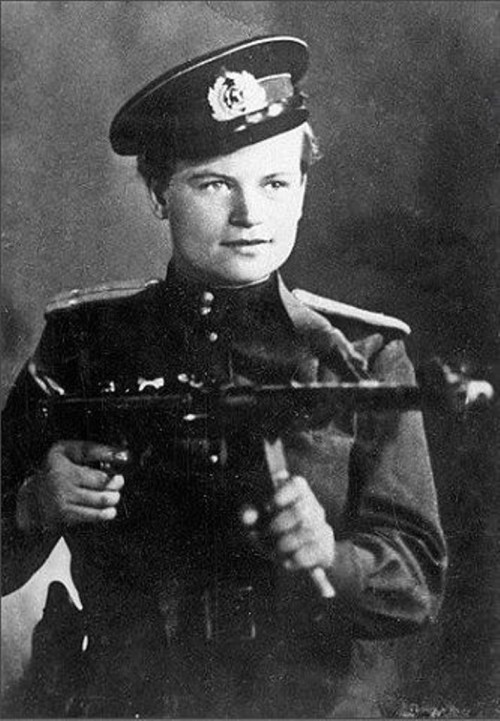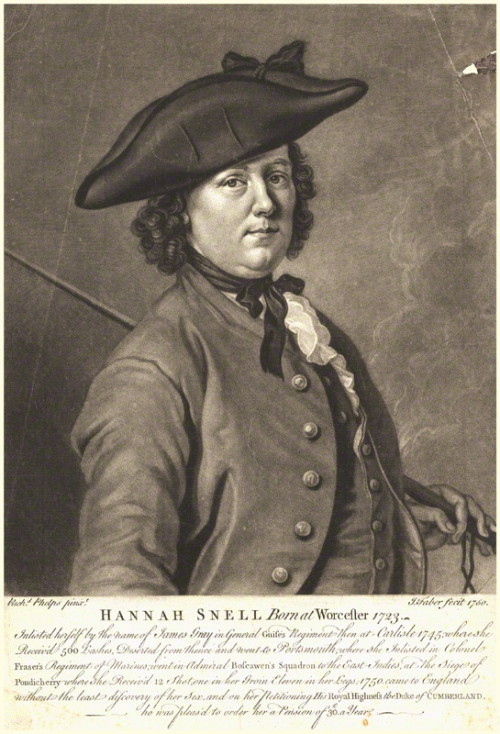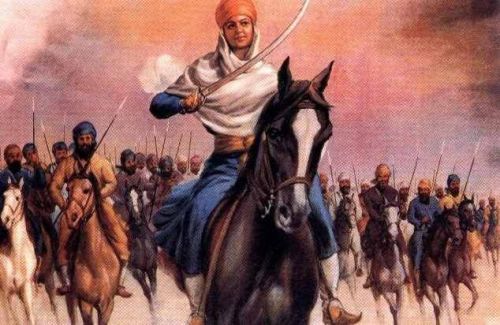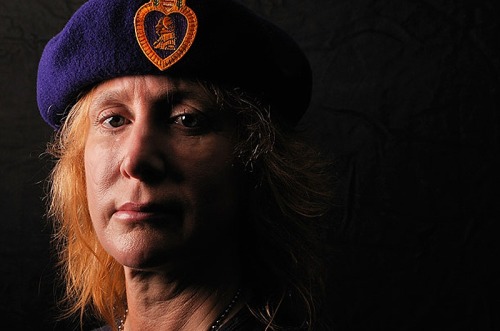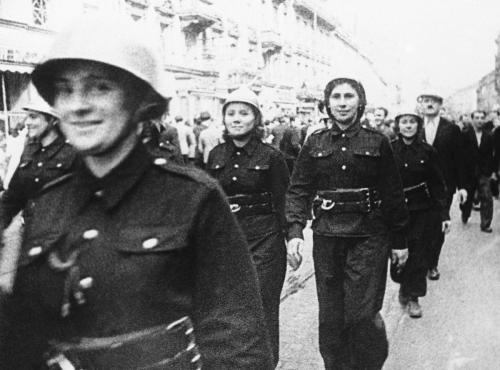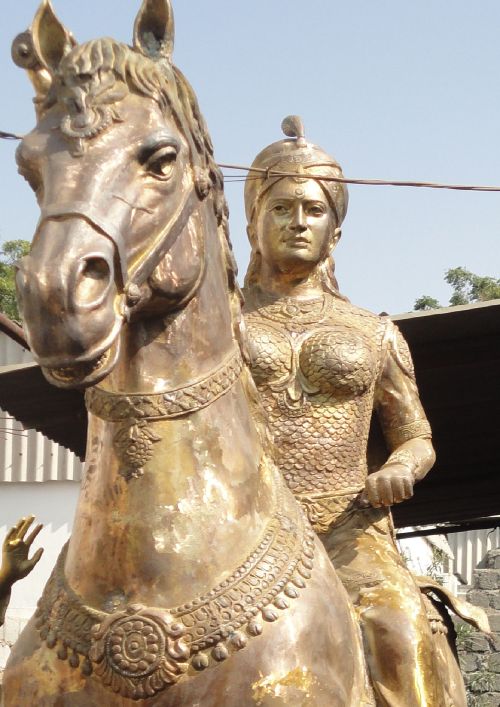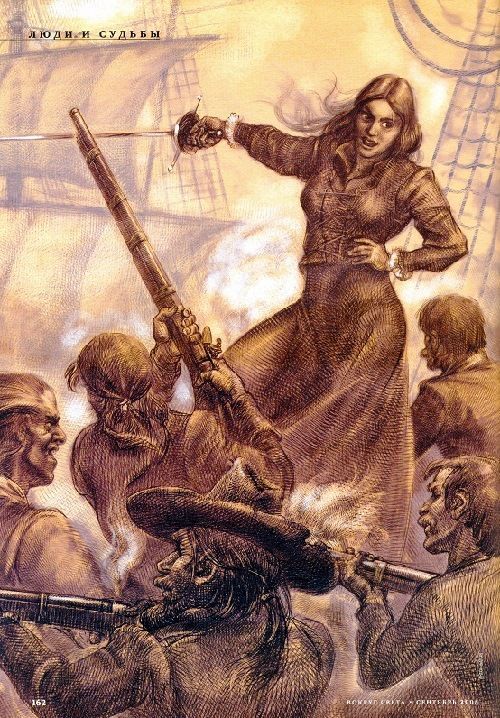#women in war
Armenian guerrilla fighters who opposed Ottoman soldiers during the Hamidian massacres, 1895. The woman on the right is known to be Eghisapet Sultanian, the other woman is unidentified.
Post link
‘Ack Ack Girls’ were members of the Auxiliary Territorial Service (ATS) that helped operate Anti-Aircraft Guns in the defense of Britain from German bombing raids during World War 2.
From 1941 onward all unmarried British women aged 20 to 30 were required to join one of the Auxiliary services, which included the ATS. One of the most dangerous and exciting ATS roles was to be selected for ‘Ack Ack’ duty, manning the Anti-Aircraft guns known for their distinctive ack-ack sound as they fired. The idea to use women in gun crews was first proposed by British engineer Caroline Haslett and was eagerly approved by Prime Minister Winston Churchill. Churchill’s own daughter, Mary Soames, was one of the first Ack Ack volunteers and served at a gun site in London’s Hyde Park.
As a royal proclamation forbade women from operating deadly weapons, Ack Ack Girls worked as part of mixed-gender squads where men would load and fire the weapons with the women’s support. The three main roles of the women were Spotters who used binoculars to find enemy planes, Range-Finding teams who calculated the distance a gun shell would have to travel to hit the target, and Predictor teams who worked out the length of the fuse necessary to make sure the shell exploded at the right height.
Women were subject to the same intensive training as men and had to undergo rigorous testing in terms of fitness, hearing, eyesight and nerves in order to be accepted. This was essential for enduring the hard conditions at the gun emplacements and to keep on task while bombs fell all around them. When the Germans deployed V1 flying bombs against Britain, 369 Ack Ack Girls were killed in just 3 months. Their sacrifice and dedication proved invaluable to the war effort, as well as providing a boost to civilian morale, the sound of the Ack Ack guns becoming a well-recognised symbol of British resistance.
Read a personal account of Ack Ack Girl, Vee Robinson, here.
Post link
TheFemale Soldier website now has a new Featured Soldier: Sara Ginaite, the Jewish Lithuanian partisan who fought to free her people from the Nazis. If you haven’t read her incredible story now is an excellent chance to check it out!
Post link
Marina Raskova (1912-1943) was a Soviet pilot, navigator, and commander who founded 3 famous female air regiments during the Second World War.
Born to a middle-class Russian family, Raskova initially had aspirations of becoming a musician, but eventually abandoned the idea to study chemistry. While working in a dye factory as a chemist she met Sergei Raskov, an engineer, who she married and had a daughter with. She changed careers in 1931 when she joined the Aerodynamic Navigation Lab of the Soviet Air Force as a draftswoman. Aged 19 in 1933 she became the first female navigator in the Air Force and the following year became the first woman to teach at the Zhukovskii Air Academy.
In 1935 she divorced from her husband and focused on her flying career. She become a famous pilot as well as a navigator, setting a number of long distance records. This included the famous ‘Flight of the Rodina’ covering 6000km from MoscowtoKomsomolsk, which she conducted with two other female pilots, Polina OsipenkoandValentina Grizodubova. However the flight ran into difficulties at the end of its 26 and a half hour journey when poor visibility hampered the landing. As the navigator’s pit was vulnerable in crash landings, Raskova bailed out with a parachute while the two pilots completed the landing. She survived with no water and almost no food for 10 days before she found her way to landing site and reunited with her team. All 3 women were decorated with the ‘Hero of the Soviet Union’ award, the first women ever to receive it.
With the outbreak of World War 2 the Soviet Union was in need of pilots and many women volunteered. However while there were no formal restrictions on Soviet women in the military, many found their applications were denied or mysteriously delayed. Raskova proposed the creation of women’s aviation units and used her celebrity status to propose the idea directly to the Soviet leader Joseph Stalin. Following a speech by Raskova in September 1941 calling for women pilots to be welcomed into the war, Stalin ordered the creation of 3 new air regiments, the 586th Fighter Aviation Regiment, the 125th Guards Bomber Aviation Regiment, and the 46th Taman Guards Night Bomber Aviation Regiment, dubbed The Night Witches. These regiments were entirely formed of women, from the pilots to the engineers to the support staff. Each regiment contained around 400 women, most of them in their early twenties, who completed 4 years’ worth of training in a matter of months.
Raskova personally took command of the 125th Bomber Regiment, for which she obtained the very best equipment available, including the state-of-the-art Petlyakov Pe-2 bombers, which caused some resentment from male units. The 125th regiment went on to fly 134 missions over the course of the war, dropping over 980 tons of bombs.
Raskova herself was killed on January 4th 1943, while attempting to lead two other Pe-2’s to a safe airfield. She was forced into making a forced landing on the Volga Bank, which resulted in the deaths of the entire bomber crew. Raskova received the first state funeral of the war and her ashes were buried in the Kremlin Wall beside those of fellow pilot, Polina Osipenko. She was posthumously awarded the Order of Patriotic War 1st Class and the regiments she created continued to serve for the duration of the war.
Post link
Laskarina Bouboulina (1771-1825) was a Greek revolutionary and naval commander.
AnArvanite Greek born in a Constantinople prison, Bouboulina was the daughter of a ship captain from Hydra island. When she was a child her father died in the Orlov Revolution, a failed Greek rebellion against Ottoman rule. After this her extensive family moved to the island of Spetses. She married twice, first to a wealth shipowner and later to a Captain Bouboulis, whose name she took. When Bouboulis was killed by pirates, Bouboulina took over his trading business and began to amass her own fleet, commissioning the construction of four new ships.
In 1816 the Ottomans tried to seize Bouboulina’s property as her husband had fought with the Russians against them during the Turko-Russian wars. She managed to thwart these attempts with the help of Count Pavel Strogonov, the Russian Ambassador in Constantinople. However she was actively working against the Ottomans as a member of the Filiki Eteria, a secret organisation plotting to overthrow Ottoman control over Greece. Her principal role was as a smuggler, bringing food, weapons, and ammunition into Spetses. She also used her wealth to construct her own personal warship named the Agammennon, one of the largest vessels of the period.
In early 1821 the Filiki Eteria and other revolutionaries began the Greek War of Independence with support from Russia and other European powers. Twelve days before the war started Bouboulina was the first to raise the revolutionary flag, flying a modified Greek flag from the mast of the Agamemnon. She assisted the people of Spetses in their revolt before sailing with eight ships to Nafplion to begin a naval blockade. She later took part in the blockade and capture of the coastal cities of MonemvasiaandPylos. She was also present at the fall of Tripoli in September 1821, and during the subsequent attack on the Ottoman garrison she gave protection to the female members of the sultan’s household. In the aftermath of the battle she bore witness to the creation of the new Greek state, the First Hellenic Republic.
Over the course of the war Bouboulina was considered an equal with other revolutionary commanders and was involved in planning their strategy. She became good friends with General Theodoros Kolokotronis and their children later married. She settled in Nafplion, the new Greek capital, until 1824 when the Greek factions turned on each other in civil war. Kolokotronis was imprisoned by his former allies and Bouboulina was arrested twice due to her association with him. She was exiled to Spetses, her fortune having been exhausted from fighting for Greek independence.
In 1825 Bouboulina was killed in an argument with the head of the Koutsis family, whose daughter Bouboulina’s son had eloped with. While confronting the family from her balcony she was shot through the head and died instantly. After her death the Emperor of Russia gave her the honorary rank of Admiral in the Russian Navy, at the time the only woman in history to hold the title. Today she is remembered as a Greek national hero without whom the Greeks might never have gained their independence.
Post link
Juana Azurduy (1780-1862), also known as Juana Azurduy de Padilla, was a South American guerrilla leader who fought for independence from Spanish rule in the early 19th century.
Azurduy was born in Chuquisaca, in what is now Bolivia but was at the time part of the Viceroyalty of Río de la Plata, a Spanish territory which controlled present day Argentina, Bolivia, Paraguay and Uruguay. She was a mestiza by birth, born to a Spanish father and an indigenous mother, however following the death of her father she was raised to be a nun in a convent. She was expelled at the age of 17 for her rebellious behaviour.
Azurduy had a deep appreciation for the indigenous people of Bolivia and in addition to Spanish she spoke the South American languages QuechuaandAymara. In 1805 she married a man who shared this passion, Manuel Padilla, with whom she had four children. When the Bolivian War of Independence began in 1809 both Azurduy and Padilla immediately joined the revolutionary forces and went on to command a 2000-strong guerrilla army in the fight against the Spanish. Padilla was later made civil and military commander for a large area around Chuquisaca and by 1813 their army numbered nearly 10,000 soldiers.
Between 1811 and 1817, Azurduy fought in 23 battles in the effort to liberate the region. During this time Azurduy dressed in male cavalry uniform, keeping her hair under a military cap, and became proficient in fighting with swords, rifles and cannon. On March 8th 1816, her forces captured the Cerro Rico of Potosí, which was the main source of Spanish silver. During the battle Azurduy personally led a cavalry charge which captured the enemy standard. For these acts she was promoted to Lieutenant Colonel and was personally honoured by General Manuel Belgrano, who gifted her with his own sword.
However Azurduy’s successes came at great cost. Her children were captured by enemy forces and although she and Padilla launched a ferocious raid to save them, all of the children were killed. Azurduy herself was injured in the attempt and Padilla was captured and killed in late 1816. When the Spanish mounted heavy counter-attacks against Bolivian forces in 1818, Azurduy retreated with her forces into Northern Argentina. Here she continued to fight the Spanish with an army of 6000. She also gave birth to a new daughter in the middle of a battle, returning to the fight shortly after the child had been born.
In 1825 Bolivia declared independence and Azurduy was able to return to Chuquisaca. However her efforts in the wars were largely forgotten and she spent the rest of her life in poverty. She died in obscurity in 1862, however her memory has been resurrected in more recent times. She is now remembered as a national hero of both Bolivia and Argentina, has posthumously been granted the rank of General in the Argentinian army, and a 52-foot high statue of her was unveiled in Buenos Aires in July 2015.
Post link
A Chechen fighter poses with her weapon in Grozny during the First Chechen War, May 1995. Chechnya’s war for independence from the Russian Federation lasted for nearly 2 years and is estimated to have claimed over 100,000 lives.
Photo by Eric Bouvet.
Post link
A member of the South Vietnamese Popular Force carries a crate of ammunition, circa 1967. These local militia fighters defended South Vietnamese villages against attacks by the Viet Cong.
Post link
Carlota was a Lucumí-Yoruba resistance fighter who led a slave rebellion in Cuba during the mid-19th century.
Kidnapped by slavers as child, Carlota was brought from West Africa to the Matanzas province of Cuba. There she worked as a slave harvesting sugar cane on the Triumvirato sugar plantation. In response to the appalling work conditions and brutal treatment by the Spanish landlords, Carlota began to plan an uprising along with another slave woman named Fermina. However Fermina’s role in the planning was discovered by the Spanish, who had her severely beaten and imprisoned.
Despite this Carlota continued to organise the uprising. Known for both her intelligence and musical skill, she sent coded messages using talking drums to coordinate a series of attacks. As the drums were a traditional instrument among the West African slaves, the Spanish were unaware that the music was also being used a form of communication. On November 3rd 1843, Carlota led a raid which freed Fermina and a dozen other slaves from captivity. On November 5th the uprising began by at the Triumvirato and Acane sugar plantations, forcibly overthrowing the Spanish owners. These attacks were led personally by Carlota, who went into battle wielding a machete.
The uprising continued for a year during which the rebels liberated slaves from at least five large sugar plantations in the Matanzas, as well as from a number of coffee and cattle estates. While many historians have focused on the physical strength of the slaves, their rebellion also showed great sophistication, using advanced guerrilla tactics and coded communication to achieve their goals. Eventually however the forces of the Spanish Governor were able to put down the rebellion due to their overwhelming numbers.
Carlota and Fermina were both captured and executed, and 1844 became known as the ‘Year of the Lashes’ due to the tide of violence inflicted upon the slave population to bring them back into line. However Carlota’s actions created a legacy which inspired numerous subsequent rebellions against white slave owners in the Caribbean. Today there is a monument to her at the Triumvirato sugar mill.
Image credit: Carlota Leading the Slaves in Matanzas by Lili Bernard. Sourced from Atlanta Blackstar.
Post link
Hannah Szenes (1921-1944) was a Jewish Hungarian resistance fighter who was parachuted behind German lines in World War 2.
The child of a Jewish family in Hungary, Szenes showed a talent for writing from a young age. She was accepted into a Protestant private school, however in spite of a ‘gifted student’ discount she still had to pay double the regular fees because she was Jewish. Combined with her awareness of the worsening situation for Jews in Hungary, this led her to join Maccabea, a Hungarian Zionist youth movement.
In 1939 Szenes traveled to the British Mandate of Palestine where she studied agriculture and wrote poetry and plays about Kibbutz life. In 1941 she joined the Jewish paramilitary force Haganah and in 1943 volunteered to join the British Special Operations Executive to train as a paratrooper. After training in Egypt she was selected to take part in an operation to infiltrate German-occupied Europe and establish links with beleaguered Jewish communities.
On March 14th 1944 Szenes was parachuted into Yugoslavia along with two men, Yoel Palgi and Peretz Goldstein. Their mission was to enter Hungary and help save Hungarian Jews from being deported to the Auschwitzconcentration camp. The team spent 3 months working with Yugoslavian partisans, during which they discovered that Hungary had been forcibly occupied by German forces in retaliation for attempting to surrender to the Allies. Faced with this new information Palgi and Goldstein decided to call off the mission. Szenes disagreed and pressed on to the Hungarian border alone, however not long after crossing she was arrested by Hungarian police.
Szenes was imprisoned and suffered a brutal interrogation by police who wanted to know the code for the radio transmitter she used to communicate with the partisans and the British. She was stripped, tied to a chair, and whipped and clubbed for 3 days. She lost several of her teeth. Yet she refused to surrender the code and so she was transferred to a Budapest prison where she continued to be tortured. Frustrated that she wouldn’t break, the guards brought in her mother, who she had not seen for 5 years, and threatened her life. Despite this Szenes still refused to give up the code and eventually her mother was released.
Szenes spent the next three months in prison but was not idle. She communicated with other prisoners using a mirror to flash signals and used large cut-out letters to spell out messages in Hebrew. She often sang to keep up the spirits of the other prisoners. However in late October she was tried for treason and on November 7th 1944 she was executed by a German firing squad.
Following the end of the war, Szenes became widely known when her diary, poetry and plays were published. She was recognised as a national heroine of Israel and in 1950 her remains were reburied in the military cemetery on Mt HerzlinJersualem.
One of the final entries in her diary contained a poem reading:
In the month of July I shall be twenty-three,
I played a number in a game,
The dice have rolled. I have lost.
Post link
Today the Female Soldier website has a new Featured Soldier: Erika Szeles, the young soldier and nurse who became the face of the 1956 Hungarian Revolution. If you missed it the first time then check out her remarkable story.
Post link
Captain Kristen Griest (left) and First Lieutenant Shaye Haver (right) have become the first women to graduate from the the US Army Ranger SchoolinFort Benning, Georgia.
Griest, a military police officer, and Haver, an Apache helicopter pilot, made history on 21st August 2015 by graduating from the Ranger School having completed an intensive 62-day course which included parachute jumps, helicopter assaults, a 5-mile run in 40 minutes and a 12-mile foot march in 3 hours. They were also trained in specialist skills such as small unit leadership and swamp survival.
This was the first time female soldiers were allowed to take part in the US Army’s toughest training as part of an ongoing effort to open up combat roles for women. The commander of the school, Major General Scott Miller, hit back against accusations on the internet that standards were lowered for the female soldiers, pointing out that the physical tests were exactly the same for all candidates and that “The 5-mile run is still 5 miles, the times do not adjust.”
Both women described how they received some skepticism from their male colleagues but this quickly evaporated as they proved themselves in the physical challenges, including their completion of a 3-day mountain march carrying 50 pounds of gear, which many of the male candidates failed to complete. Moving forward Griest has expressed an interest in joining a special forces unit, although such roles are currently unavailable to women in the US Army. Haver stated that she will be returning to her role as a helicopter pilot.
—
Newspaper sources:
- http://www.reuters.com/article/2015/08/20/us-usa-military-women-idUSKCN0QP0CE20150820
- http://www.theguardian.com/us-news/2015/aug/21/women-graduate-us-army-ranger-school
- http://news.yahoo.com/army-pilot-military-cop-1st-women-pass-ranger-090909029.html
- http://ktla.com/2015/08/20/2-women-set-to-be-first-ever-female-graduates-of-grueling-us-army-ranger-school/
Post link
An Italian Maquis freedom fighter braves the hazardous conditions of the Alps at Little St Bernard Pass, 4th January 1945. The Italian Maquis were a resistance movement which fought against German Nazis and Italian fascists before and during World War 2. Formerly a school teacher, this woman chose to fight alongside her husband as part of the Maquis ‘White Patrol’.
Post link
LadyFu Hao was a queen, general and high priestess of the Shang dynasty in Eastern China during the 13th Century BCE.
Fu Hao first became known when she married the Shang king, Wu Ding, and became one of his 60 wives. Fu Hao took advantage of the semi-matriarchal slave society to ascend through the ranks of the royal household, gain a leading position in the Shang army and become Wu Ding’s most favoured wife.
As a warrior Fu Hao gained notoriety for her efforts against the Tu-Fang, who despite having been fierce rivals of the Shang for generations were completely defeated by Fu Hao in a single decisive battle. She went on to become the Shang’s most powerful military leader commanding a force of 13,000 soldiers with several other generals in service to her. She led successive military campaigns against the neighboring kingdoms of the Yi,QiangandBa. The last of these involved her leading the earliest recorded ambush in Chinese history.
Like other war chiefs Fu Hao was granted a fiefdom of land from the territories she conquered, from which she derived her own income. She was also an active politician and spiritual leader, acting as an adviser to the king and performing religious rituals as a high priestess. These were unusual roles for a woman at the time and reflected the faith that Wu Ding placed in her.
Following Fu Hao’s death the Shang’s military dominance weakened under attacks by the Gong, causing Wu Ding to make repeated sacrifices and prayers to Fu Hao’s spirit to defend them against invasion. Over the centuries Fu Hao’s accomplishments descended into myth and many historians did not believe that she had really existed until her tomb was uncovered at Yinxu in 1976. The tomb contained detailed records of her life on oracle bone, as well as an arsenal of weapons including battle-axes bearing her personal inscription.
Post link
Yevdokiya Zavaliy was a Soviet nurse, soldier and marine commander who fought in World War 2.
Born in 1924, Zavaliy was raised in a small village in the Mykolaiv region of Ukraine, where she worked on a farm. She was brutally exposed to the outbreak of World War 2 when enemy planes bombed her village and in the aftermath she treated injured soldiers by ripping up bed sheets from her home to make improvised bandages. The event left such an impression on her that she persuaded the commander of a cavalry regiment to take her with them to the front line, claiming to be 18 years old when she was in fact 16.
Zavaliy started serving with the regiment as a nurse, but during this time she learned to shoot rifles, pistols and machine guns. She also became directly involved in conflicts, taking a wound to the abdomen during the retreat at Khortytsia island and saved the life of a wounded officer by dragging him to safety. She was awarded the Order of the Red Star for her bravery, but this was only to be the first decoration she would receive.
One day an officer mistook Zavaliy for a man as she wore soldier’s clothes and her head had been shaved to remove lice. The officer ordered her to join a group of soldiers headed to the front line. Zavaliy decided to go along with the mistake and two hours later she took part in a battle near Goryachy Kluch with the 6th Airborne Brigade. She continued to serve in numerous battles under her new male identity and following her capturing of a German officer in combat she was appointed to commander of a reconnaissance squad. When Soviet troops were starving near Mozdok in late 1942, Zavaliy mounted a daring night raid across a river to a German camp, where she stole ammunition and provisions before sailing away on a raft.
The following year Zavaliy was a sergeant serving in the Kuban region when her company was surrounded during a heavy firefight and the company commander was killed. Seeing her fellow soldiers faltering Zavaliy took command, shouting for the men to follow her and leading them in a furious counter-attack which broke the enemy and sent them into retreat. The battle left her seriously injured and during her treatment the doctors discovered that she was a woman. Zavaliy expected to be dismissed and return to nursing, however in light of her many achievements she was allowed to stay in the army and in October 1943 she was promoted to commander of a submachine gunner platoon.
While the men of her platoon were initially reluctant to follow the orders of a teenage girl, Zavaliy quickly won their respect. The platoon was repeatedly deployed to the forefront of the most intense fighting, where Zavaliy led her men in daring attacks on German lines, taking part in the defense of the Caucasus, the battle for Crimea and ultimately the Soviet expansion across Eastern Europe. She became so feared by German soldiers that they nicknamed her ‘Frau Black Death’. Twice she was believed to have been killed in action but both times she returned unscathed. In her military career she was wounded a total of 4 times and received approximately 40 medals of honour.
Zavaliy was eventually discharged from the army in 1947 and traveled to Kiev where she married and had 2 children. She spent much of her life working as the manager of a grocery store but also toured many Soviet cities and army bases where she was celebrated as a military hero. She died in Kiev in 2010.
Post link
Janina Forbertówna was a Polish resistance fighter who took part in the Warsaw UprisingagainstNazi occupation in 1944. Using the codename ‘Jasia’ she worked as a liaison officer in the communist partisan Armia Ludowa, or 'People’s Army’. What became of her after the failed uprising is unknown.
Post link
Hannah Snell (1723-1792) was a famous British soldier in the 18th century.
Born in Worcester in England, Snell is said to have had a fascination with soldiers even as a child. When she was a young woman she moved to London and in 1744 married a man named James Summs. The couple had a daughter, but the child died only one year old and Summs disappeared. Hearing a rumour that Summs had been pressed into military service, Snell borrowed the clothes of her brother-in-law, James Gray, and assumed his identity to join the British army and locate Summs.
Although she later discovered that Summs had been convicted and executed for murder, this did not prevent Snell from pursuing an adventurous military career disguised as James Gray. According to her own account she became a soldier in the 6th Regiment of Foot, where she was stationed in Carlisle during the Jacobite rebellion in Scotland. During this time she was trained in military drill and the use of firearms. However after she prevented a sergeant from raping a local girl she was sentenced to 600 lashes of the whip for ‘neglect of duty’. As she endured the first 500 lashes without making a sound her commanding officer ordered that she be spared the final 100 lashes.
Snell left the regiment after this and instead decided to travel to Portsmouth where she joined the British Royal Marines and set sail to India on the Swallow. In 1748 Snell fought in the naval Battle of Pondicherry where the British attempted to capture a French colony. She reportedly killed several Frenchmen before being wounded herself. She is also known to have fought in a battle at Devicotta and was wounded a total of 12 times during her naval service, including suffering a musket shot to the groin. She operated on herself to remove the musket ball so that she wouldn’t be identified as a woman by the ship’s surgeon.
In 1750 Snell returned to Britain and decided to finally reveal her true identity to the other members of her unit. With the encouragement of her shipmates she petitioned the head of the British army, the Duke of Cumberland, to grant her a military pension. Remarkably, the pension was granted and she was honourably discharged from the army. Snell’s exploits became popular gossip around London and she eventually sold her story to a London publisher under the title ’The Female Soldier’.
Snell retired to Wapping where she opened a pub named ’The Female Warrior’. She lived for another 40 years, married twice more and raised 2 sons. In her old age Snell began to suffer from dementia and in 1791 she was admitted to the Bedlam asylum where she died 6 months later.
Post link
An Israeli soldier armed with an Uzi submachine gun during the 1967 Six Day War between Israel and neighbouring Egypt, Jordan, and Syria.
Post link
Pingyang (598-623) was a rebel general and later princess who helped found the Tang Dynasty in China.
During the early 7th Century, China was ruled by Emperor Yang of the Sui Dynasty, who was extremely unpopular thanks to starting numerous wars and ordering construction projects to expand the Great WallandGrand Canal which worked 6 million people to death. Pingyang’s father, Li Yuan, was one of Yang’s most successful generals. However in 617 the Emperor became paranoid about Li Yuan’s popularity and ordered for him to be executed. In response Li Yuan rose up in open rebellion against Yang’s rule.
At this time Pingyang was living in the capital, Chang’an, where her husband Cai Shao was head of the palace guard. With the news of Li Yuan’s rebellion the pair were forced to flee the city, separating to improve their chance of escape. Pingyang returned to her family estate to find the region was suffering from severe drought. She opened up the estate’s food stores to feed the local people and in doing so was able to recruit many of them to form her own army to fight against the Emperor, dubbed ‘The Army of the Lady’.
Selling everything her family owned to fund her rebellion, Pingyang added to her forces by assimilating the armies of local warlords, either through bribery or by defeating them on the battlefield and recruiting the surviving soldiers. She ultimately became commander of a force of over 70,000 rebels. She forbade her troops from looting, pillaging, or raping, instead insisting that after conquering an area that food should be distributed to the locals. Unsurprisingly this gained her immense popular support, increased even further by her repeated victories against the Emperor’s armies.
Joining up with the armies of her father and her husband, Pingyang’s forces captured the capital within a year. Yang fled the city and was later killed by his own men. Li Yuan became Emperor Gaozu of the newly founded Tang Dynasty, while Pingyang officially became a princess in addition to being awarded the rank of Marshall and the honorific title zhou, meaning ‘wise’. However she only lived a few years in this role, dying aged only 23 of unknown causes. On her death, her father broke with tradition and insisted that Pingyang was given a military funeral in honour of her achievements.
Klavdiya Kalugina was one of the youngest Soviet snipers who fought during World War 2.
Born in 1926, Kalugina was aged 15 when Germany invaded the Soviet Union in 1941, at which time she was working in a munitions factory. Shortly after the invasion she joined the Komsomol (Communist Youth League) and in 1943 she was accepted into a Komsomol sniper school. Although she initially struggled with the training, Kalugina credited her graduation from the school to the patience of her squad commander.
Kalugina was sent to the front lines in March 1944 where she joined the 3rd Belorussian Front. Aged 17, she operated in a sniper/spotter team with a girl who she had trained with, Marusia Chikhvintseva. Her usual weapon was a Mosin-Nagant rifle with a PU scope, with which she engaged enemies at distances from as close as 200 metres to as far as 1200. She described her objective as eliminating key targets such as enemy commanders and machine gun emplacements, making one shot per day from a heavily camouflaged position and then returning to base at night.
Kalugina survived the war, although her partner, Chikhvintseva, did not. There is no account of her life following the end of the war.
An interview with Kalugina describing her experiences of her wartime experiences in detail can be read here.
Post link
Mai Bhago, also known as Mata Bhag Kaur, was a Sikh woman who fought against the Mughal Empire in the early 18th century.
Mai Bhago was born in the village of Jhabal Kalan in the Punjab region of northern India, were in addition to being taught Sikh traditions she was trained by her father in horse riding and martial arts. She was a young woman during the period when oppression of Sikhs by the Mughal Empire was at its height. During 1704-05, the expansionist Mughal Emperor, Aurangzeb, invaded Sikh territory with an army of 16,000 troops and laid siege to the Sikh capital of Anandpur Sahib.
During the siege the Sikh leader, Guru Gobind Singh Ji, was abandoned by 40 of his elite warriors. Many of these men came from the region that Mai Bhago lived in and according to some accounts one of the deserters was her own husband. Outraged by this betrayal, Mai Bhago took her own horse, armour, and weapons and left home to track down the deserters. She went to their homes and persuaded their wives not to give their husbands shelter. Some of the women even armed themselves and joined Mai Bhago, pledging to fight for the Guru if their husbands would not. Shamed by this, the 40 deserters agreed to return to service with Mai Bhago.
During this time the Guru had escaped from the siege of Anandpur and was in retreat with his army. On 29th December 1705, Mai Bhago’s small force helped to cover the Guru’s retreat at the Battle of Muktsar. Knowing that the pursuing Mughals would need water she set up camp at the Khidrana reservoir, erecting numerous empty tents and clothes lines to make it appear as if a larger army was encamped there. When the Mughal army attacked the empty tents Mai Bhago’s force ambushed them and in spite of being heavily outnumbered managed to push the Mughals back after intense fighting. Although victorious, Mai Bhago was the only Sikh survivor of the battle.
After the battle Mai Bhago joined up with the Guru’s army and became his bodyguard. After the Guru’s death in 1708 she retired to Jinvara, where she lived to an old age. Today she is remembered as a Sikh heroine whose actions served to ensure the survival of her faith.
Post link
Susan Sonnheim is an American veteran formerly of the Wisconsin National Guard who served in the Iraq War. While on duty Sonnheim was the victim of a roadside bomb in Baghdad which left her body filled with shrapnel, blinding her in one eye as well as causing injuries to her spine and limbs. She only survived the attack because the bullet that penetrated her Kevlar vest and would have killed her was stopped by a tobacco tin in her pocket. Following her injuries, Sonnheim became the first woman in the National Guard to receive the Purple Heart medal awarded to wounded soldiers.
Since returning home to the US, Sonnheim has described a lack of acceptance of her veteran status because she is a woman and says there is gender bias in the care that American soldiers returning from war receive. She is quoted in The Guardiansaying“There is no reason for women not to be in combat. It’s a buddy system – you look after the person next to you whether they are male or female. Once you are a soldier, that’s the way it is, a soldier is a soldier.”
Photo credit: Tom Sperduto, sourced from TIME magazine.
Post link
Queen Nzinga Mbande (1583-1663), sometimes referred to as Anna Nzinga, was ruler of the NdongoandMatamba Kingdoms of the Mbundu people in what is now Angola.
As the favoured daughter of King Kiluanji of the Ndongo, Nzinga Mbande was brought up witnessing her father’s governance of the kingdom first-hand. He even took her with him when he went to war. Kiluanji made deals with the Portuguese who were expanding their slave trading operations in South West Africa, and this relationship was maintained when her brother Ngola Hari became king. However in 1617 the Portuguese Governor Correia de Sousa launched attacks against the Ndongo kingdom that captured thousands of Mbundu people.
In 1621 when the Portuguese invited the Ndongo king to take part in peace talks, he sent his sister Nzinga Mbande in his place. At her famous first meeting with De Sousa chairs were only provided for the Portuguese, and Mbande was expected to sit on the floor. Instead she commanded one of her servants to go down on all fours and act as her chair. During the negotiations Mbande walked a fine line between preventing the Portuguese from controlling the kingdom as they had done in Kongo, while keeping options open to trade for firearms to strengthen her armies. In this she was successful, although as a condition of the agreement she had to convert to Christianity and was baptised as Anna de Sousa, with the Governor becoming her Godfather.
In 1626 Mbande became Queen of the Ndongo following the death of her brother. Her reign began in peril as the Portuguese went back on their deal with her and declared war, as did other neighbouring tribes. Forced into retreat from her own lands, Mbande led her people south to the kingdom of Matamba, which she attacked, capturing Matamba’s Queen and routing her army. Mbande then installed herself as the new ruler of Matamba, from where she launched a prolonged campaign of guerrilla warfare against the Portuguese which would last for the next 30 years.
Mbande developed a legendary reputation as a warrior, although claims that that she took part in human sacrifice are likely the result of European propaganda and gossip. Accounts that she maintained a personal harem of more than 50 men are also unproven. What is known is that Mbande assembling a diverse army to oppose the Portuguese that included runaway slaves, defecting soldiers, and women. Exploiting European rivalries she made an alliance with the Dutch, which included acquiring her own personal bodyguard of 60 Dutch elite soldiers armed with rifles. Working with the Dutch, Mbande successfully defeated Portuguese armies in 1644, 1646, and 1647. However the Dutch were eventually pushed out of the region in 1648 and Mbanda was forced to carry on the fight alone. While she was never able to completely defeat them, she successfully resisted Portuguese invasion for decades.
Mbande continued personally leading her troops into battle until she was in her sixties, but the long war eventually wore both sides down. In 1657 she finally signed a peace treaty with Portugal. She then spent the rest of her life focused on rebuilding a nation which had been devastated by conflict and over-farming. She died of natural causes in 1663, aged 81. Today Nzinga Mbande is a symbol of Angolan independence, memorialised by numerous statues.
Post link
It’s Women’s History Month and the Female Soldier website is adopting a new Featured Soldier! Milunka Savić was the most decorated woman in the history of war. In addition to her native Serbia, this heroine received medals from France, Russia, and Britain for her bravery in World War I.
Post link
Polish women march through the streets of Warsaw as part of the city’s defense forces during the German Invasion of Poland, 16th September 1939.
Photo from The Atlantic.
Post link
Rudrama Devi (1245-1289) was a Warrior Queen of the Kakatiya dynasty in the Deccan Plateau of Southern India.
Rudrama Devi rose to power in 1259 during her early teens when she was appointed co-regent to jointly rule alongside her father, King Ganapati. While Ganapati had no sons, he gave her the male name of Rudra Deva and formally declared her to be his male heir, an image which she did nothing to deter as she dressed in male clothes. She married Veerabadra, a prince of Nidadavolu, with whom she had two female children, but he suffered an early death.
The first few years of Rudrama’s conjoined rule with her father were marred by a Pandya invasion led by Jatavarman Sundara Pandyan I. While the invasion was eventually repelled, the Kakatiyas suffered a number of significant defeats and the kingdom was left in a weakened state. As a result of these failings her father withdrew from public life while passing control to Rudrama, and on his death in 1269 she was officially crowned as Rani (Queen). A number of noblemen, possibly including her own step-brothers, refused to submit to a woman’s authority and rose up in rebellion against her. However Rudrama rallied an army with those nobles and chiefs still loyal to her and successfully crushed the rebellion.
Having secured her kingdom Rudrama spent the rest of her rule defending it from external threats. The Kakatiya were one of four major powers in Southern India who were frequently at war with each other. The Yadava king Maha Deva launched a sustained invasion on the Kakatiya from 1268 to 1270, culminating in a siege of the Kakatiya capital of Orugallu (now Warangal). After 15 days of fighting, an attack led by Rudrama routed the Yadavas and she pursued them in a long retreat back to their own territory during which many Yadavas were captured. Soundly defeated, Maha Deva was forced to pay an enormous ransom for the release of his soldiers. A later invasion by the Odias was also defeated by Rudrama’s generals.
While adept at warfare, Rudrama was also known to have been an effective administrator and when Orugallu was visited by Marco Polo he described her as a lady of discretion who ruled with justice and equity. She also completed work on the Orugallu Fort, adding a second wall and a moat to the structure, which protected the city against numerous future sieges.
In 1280 Rudrama passed the mantle of leadership on to her grandson, Prataprudra, as she was growing old and had no male children of her own. However in 1285 a new threat arose in the form of the Kayastha Chief, Amba Deva, who had allied with the Pandyas and Yadavas to destroy the Kakatiya empire. Though elderly, Rudrama led an army to meet this three-pronged attack head-on, but was killed in the ensuing battle. The Katakiya empire would crumble over the following years, however Rudrama Devi’s legacy is still well remembered in Southern India.
Post link
Gráinne Ní Mháille (c.1530 - c.1603), commonly known as Grace O'Malley, was a legendary Irish pirate and Chieftan of the Ó Mháille clan during the 16th century.
Born around 1530, Ní Mháille was the child of a wealthy sea trader who she accompanied on his voyages from a young age. As a teenager she was married to Donal Ó Flaithbheartaigh, heir to a powerful clan, as a political move. The marriage lasted for 19 years, during which they had three children and Ní Mháille gained considerable experience commanding ships in her husband’s fleet.
Following the death of her husband and her father, Ní Mháille inherited a considerable amount of money and took over her father’s fleet of 20 ships and hundreds of sailors. She built on her father’s success to become one the dominant forces on the Irish west coast, launching raids on rival clans, forcing merchant ships to pay for safe passage, and imposing taxes on fishermen as far away as England. She also transported Gallowglass mercenaries between Scotland and Ireland, often raiding Scottish islands at the same time. Her position was strengthened by the control of several coastal castles, most prominent of which was Rockfleet Castle, which she gained through her second marriage to Risdeárd Bourke. After a year of marriage she is said to have taken control of the castle, barring Bourke from entering and yelling from a window, “I dismiss you!”.
Ní Mháille had a tumultuous relationship with the English. From the early 1560’s onward she was accused of piracy multiple times, but she won some favour with the English by assisting in coastal attacks on southern Ireland and won the respect of Sir Henry Sidney, the Lord Deputy of Ireland. However n 1579 she was besieged in her castle by English forces, who she defeated by pouring hot oil on the attackers and according to some accounts by making homemade bullets from melted down armour.
Ní Mháille made a lasting enemy in the form of Richard Bingham, the English ruler of Connacht, after she fought alongside the Bourkes in open rebellion against him from 1585 to 1589. Bingham sought revenge for the rebellion by targeting Ní Mháille, destroying her lands and property. Bingham killed Ní Mháille’s eldest son, Eoghan, and captured his castle, while making a deal with one of her other sons, Murchadh, to switch sides. Ní Mháille swore never to speak to Murchadh again after his betrayal and burned his lands.
Financially ruined, the final blow to Ní Mháille came in 1593 when Bingham captured her other son, Tiobóid, as well as her brother and threatened them with charges of treason. Ní Mháille petitioned Queen Elizabeth of England directly to ask for their release. Elizabeth sent Ní Mháille a list of questions which she answered, and later that year the two women met at Greenwich Palace near London. Despite Ní Mháille’s rough manners and refusal to bow, the two women, both in their sixties, seemed to develop a healthy respect for each other. As neither spoke the other’s language they conversed in Latin, striking an agreement that Ní Mháille’s family would be released, reparations would be made for her stolen property, and that Bingham would be removed from power.
The agreement did not last. Reparations were not fully made, and while initially stripped of his position, Bingham was eventually allowed to return to power in Ireland. Angered, Ní Mháille returned to helping Irish rebels during the Nine Years’ War. She died of old age in Rockfleet Castle at the end of the war in 1603. After her death Ní Mháille’s fighting prowess led to many Irish folk tales being told about her and she is still remembered as a legendary pirate.
Post link
Artist’s depiction of a Sarmatian warrior
Amage was a Sarmatian warrior queen who lived toward the end of the 2nd Century BCE.
Amage was queen of the Sarmatians, an Iranian people who lived in the western region ofScythia on the coast of the Black Sea. According to the Greek strategist Polyaenus, while Amage’s husband, Medosaccus, was officially the Samartian king, Amage deemed him to be an unworthy ruler who abused his power for personal luxury. She took control of the Sarmatian government and military, using her power to build defensive garrisons which she used to defend her lands on multiple occasions.
Her success as a leader made her famous throughout Scythia and led to the neighbouring Chersonesians to ask for her help when they were being threatened by the Crimean Scythians. Amage agreed to the alliance, sending a message to the Scythian king demanding that he leave the Chersonesians in peace. When the king refused she gathered a force of 120 seasoned warriors, equipping them with 3 horses each so they could cover ground quicky. Marching toward the Scythian palace they covered a distance of more than a 100 stades (180 kilometres) in a single night and a day. The swiftness of the attack caught the Scythian forces off guard and they were easily defeated. Personally leading the assault on the palace, Amage broke into the Scythian king’s quarters and killed him along with his entire family save for one of his sons. She installed the boy as the new Scythian ruler, on the condition that Chersonesus would remain free and that the Scythians would never again attack their neighbours.
While little else is recorded of Amage’s rule, Sarmatian women became known for having a prominent role in war and are recorded by Herodotus as fighting in the same clothing as men. Some believe that the exploits of Amage and similar Sarmatian women served as the inspiration for the Greek myth of the Amazons.
Post link
Minnie Spotted Wolf (1923–1988) was the first Native American woman to serve in the United States Marine Corps.
A member of the Blackfoot tribe, Spotted Wolf spent her childhood working on her father’s ranch in Heart Butte, Montana, where she cut fence posts, drove trucks and broke horses. She first expressed an interest in joining the army when she was aged 18, shortly after the US entered into World War 2 at the end of 1941. However she was initially discouraged by a recruitment officer who told her that the war was ‘not for women’.
Spotted Wolf was eventually accepted into the Marine Corps Women’s Reserve in July 1943, making her the first Native American female Marine. She almost did not accept the post as her father was dying from a horse riding accident, however her mother and sister strongly encouraged her to pursue her ambitions. She underwent rigorous boot camp training at Camp Lejeune, during which she gained 15 pounds of weight from the diet and rigorous exercise. She later described the training as “hard, but not too hard” given her background on the ranch.
On completion of her training Spotted Wolf went on to serve 4 years in the Marines in California and Hawaii. She drove trucks loaded with heavy equipment, a job normally reserved for men, and also sometimes worked as a jeep driver for visiting generals. Spotted Wolf’s career quickly gathered media attention and she was featured in numerous news stories, and even her own comic book, to promote the war effort.
Following her discharge in 1947, Spotted Wolf returned to Montana where she married a farmer named Robert England with whom she had four children. She attended college to qualify as a teacher and spent the next 29 years teaching in reservation schools. She died in 1988 aged 65 and was buried in her military uniform.
Post link
A 106-year-old woman guards her home in Degh village, near Goris in southern Armenia, 1990. The Nagarno-Karabakh War between Azerbaijan and Armenia displaced hundreds of thousands of people from their homes.
Photo by Armineh Johannes.
Post link







